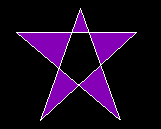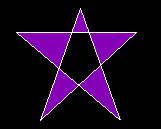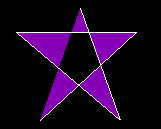![[Previous]](../prev.gif) |
![[Contents]](../contents.gif) |
![[Index]](../keyword_index.gif) |
![[Next]](../next.gif) |
![[Previous]](../prev.gif) |
![[Contents]](../contents.gif) |
![[Index]](../keyword_index.gif) |
![[Next]](../next.gif) |
 |
This version of this document is no longer maintained. For the latest documentation, see http://www.qnx.com/developers/docs. |
Draw a stroked and/or filled polygon
int PgDrawPolygon( PhPoint_t const *ptr,
int num,
PhPoint_t const *pos,
int flags );
int PgDrawPolygonv( PhPoint_t const *ptr,
int num,
PhPoint_t const *pos,
int flags );
int PgDrawPolygonCx( void *dc,
PhPoint_t const *ptr,
int num,
PhPoint_t const *pos,
int flags );
int PgDrawPolygonCxv( void *dc,
PhPoint_t const *ptr,
int num,
PhPoint_t const *pos,
int flags );
ph
These functions build a command in the draw buffer to draw a polygon from an array of points, pointed to by ptr, with num entries.
 |
The array of points must fit in the draw buffer for all these functions. |
PgDrawPolygon() and PgDrawPolygonv() work on the current draw context, while you can specify the draw context dc for PgDrawPolygonCx() and PgDrawPolygonCxv().
The flags argument must be one of the following:
You can OR flags with any combination of the following:
For absolute coordinates, pos is added to each point pointed to by ptr. For relative coordinates, the first coordinate is the sum of pos and the first point of the array; any subsequent coordinate is the sum of the previous point and the next point of the array.
 |
If you call the “v” forms of this function, the data isn't physically copied into the draw buffer. Instead, a pointer to the array is stored until the draw buffer is flushed. Make sure you call PgFlush() or PgFlushCx() before you modify the point array. |
The following example:
DrawFillStrokePoly() {
PhPoint_t o = { 0, 0 };
PhPoint_t p[] = { 80, 8, 120, 120, 16, 32,
136, 32, 40, 120 };
PgSetStrokeColor( Pg_WHITE );
PgSetFillColor( Pg_PURPLE );
PgDrawPolygon( &p, 5, &o, Pg_DRAW_FILL_STROKE |
Pg_CLOSED );
}
will draw:

The following example:
DrawRelPoly() {
PhPoint_t o = { 0, 0 };
PhPoint_t p[] = { 80, 8, 40, 112, -104, -88,
120, 0, -96, 88 };
PgSetStrokeColor( Pg_WHITE );
PgSetFillColor( Pg_PURPLE );
PgDrawPolygon( &p, 5, &o, Pg_DRAW_FILL_STROKE |
Pg_CLOSED |
Pg_RELATIVE );
}
will draw:

The following example:
DrawUnclosedPoly() {
PhPoint_t o = { 0, 0 };
PhPoint_t p[] = { 80, 8, 120, 120, 16, 32,
136, 32, 40, 120 };
PgSetStrokeColor( Pg_WHITE );
PgSetFillColor( Pg_PURPLE );
PgDrawPolygon( &p, 5, &o, Pg_DRAW_FILL_STROKE );
}
will draw:

Photon
| Safety: | |
|---|---|
| Interrupt handler | No |
| Signal handler | No |
| Thread | No |
To draw stroked polygons, see also:
PgSetStrokeColor*(), PgSetStrokeCap*(), PgSetStrokeDash*(), PgSetStrokeDither*(), PgSetStrokeJoin*(), PgSetStrokeWidth*()
To draw filled polygons, see also:
PgSetFillColor*(), PgSetFillDither*(), PgSetFillTransPat*()
“Arcs, ellipses, polygons, and rectangles” in the Raw Drawing and Animation chapter of the Photon Programmer's Guide
![[Previous]](../prev.gif) |
![[Contents]](../contents.gif) |
![[Index]](../keyword_index.gif) |
![[Next]](../next.gif) |